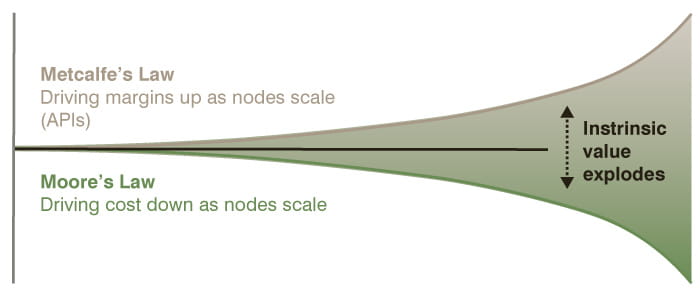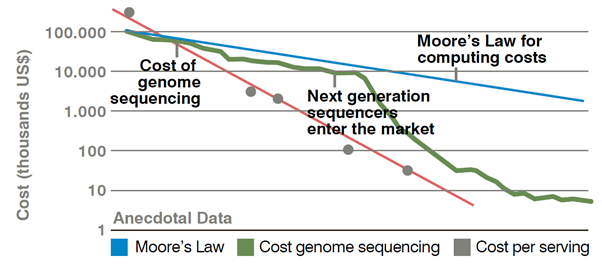A quarter of global emissions are connected to food and a third of food that is created goes to waste. Both these facts are driving the need for change on a huge scale. GAM Investments’ Mark Hawtin considers the future of food and explains why it looks set to be one of the most exciting prospects for the next 10-15 years.
09 August 2022
Click here to view the Disruptive Strategist newsletter in full.
When we look at investing in disruption, we seek to find themes that have the potential to be substantial and grow at a geometric pace. Food has not, until now, stood out in that regard. However, we believe climate change and the development of technology are now creating a tipping point in food not unlike that of the smartphone in 2007.
Research carried out by Hannah Tucker at Balance Point Ventures suggests there are three potential outcomes for the future of food:
- A Doomsday scenario, namely the collapse of nature if we do not make seismic change;
- A synthetic world where nature is controlled; and
- A regenerative world, where we see a collaboration of new and old to generate better outcomes that are more sustainable and less destructive to the environment.
Clearly the first scenario is not an option; in the words of Ban Ki-moon, there is no Planet B and we believe that the third scenario, while additive, cannot begin to resolve the issues at scale. This means that synthetic foods are going to meet a large part of the requirement for sustainable foods over the next 10-20 years. They are already being driven by the geometric laws that support hypergrowth and thus meet the requirements of disruption that we look to identify.
25% of global emissions are connected to food and a third of food that is created goes to waste. Both these facts are driving the need for change on a huge scale. Further, 99% of fish face extinction as acidity levels rise, coral reefs are destroyed and phytoplankton decline precipitously. In short, ocean and land-based ecosystems must change. Technology is now able to contribute to that change in the same way as it has in other industries, driven by Moore’s Law and Metcalfe’s Law.

The ability to operate on an electron level allows for developments in the synthetic world that were not viable only a few years ago. In just the same way that Moore’s Law has driven down the cost of genome sequencing, it has also driven down the cost of producing synthetic meat, for example. The chart below shows that in the words of Ron Shigeta, the co-founder of science accelerator IndieBioshows, “lab-grown meat is scaling like the internet”.
Lab grown meat costs behave like tech


There is huge resistance in accepting manufactured substitutes for existing foods like meat and mass adoption will depend on much more than just the need to create sustainable alternatives. One of the most far-reaching pieces of work on the subject has been done by RethinkX, a UK-based think tank, and in its report, Rethinking Food and Agriculture, it estimates that the number of cows in the US will fall 50% by 2030, rendering the cattle industry all but bankrupt. This depends heavily on adoption of alternatives and we believe that this, in turn, depends on a catalyst that will make that change inevitable. This is where Moore’s Law kicks in. As the chart above shows, with manufactured meat costs declining rapidly, it will be cheaper to eat alternatives and we believe that will be the tipping point – economic rather than ecologic.
The world of sweeteners offers another insight into the potentially far-reaching impact of food alternatives. Precision fermentation is one of the latest and most rapidly developing fields, garnering huge amounts of venture backing. The ability to analyse and work with organisms at the molecular level allows for many more areas of innovation – DNA sequencing for plants, for example. New plant-based proteins that have all the characteristics of sugar are being discovered and manufactured, although presently only in small quantities. These proteins like Brazzein, Monelin or Miraculin are thousands of times sweeter than conventional sugars or sweeteners and as proteins, they have potential health benefits. The problem has been manufacture at scale but with the advances being made in precision fermentation and the belief that (like meat substitutes) these will follow a geometric path of improvement, the prospect of protein-based alternatives is on the verge of commercialisation. They are already being tested by major customers like Coca-Cola and Pepsi. We consistently talk about the polarisation of winners and losers in a truly disruptive world. It is easy to see that in the world of sweet flavours, manufactured alternatives might take over that world, rendering the existing sugar industry redundant. Just imagine the implications for a country like Brazil that is the world’s largest producer of sugar!
There are very few ways to invest in this theme in the public markets. Beyond Meat is perhaps the best known, but in our view it does not attack the real disruption coming down the track. Precision fermentation is an extremely exciting prospect that sits either in very small parts of industrial conglomerates like Cargill or in the private world, with names like Perfect Day and Impossible Foods. GFI reports that USD 1.7 billion has been invested in fermentation companies focused on alternative proteins in 2021, double the 2020 number. It is early days but as always, we are looking for the next wave of disruption in readiness for the investment opportunity. This theme, driven by both a chronic global need and the tipping point in technology, looks set to be one of the most exciting prospects for the next 10-15 years.
The information in this document is given for information purposes only and does not qualify as investment advice. Opinions and assessments contained in this document may change and reflect the point of view of GAM in the current economic environment. No liability shall be accepted for the accuracy and completeness of the information. Past performance is not a reliable indicator of future results or current or future trends. The mentioned financial instruments are provided for illustrative purposes only and shall not be considered as a direct offering, investment recommendation or investment advice. The securities listed were selected from the universe of securities covered by the portfolio managers to assist the reader in better understanding the themes presented and are not necessarily held by any portfolio or represent any recommendations by the portfolio managers. There is no guarantee that forecasts will be realised.